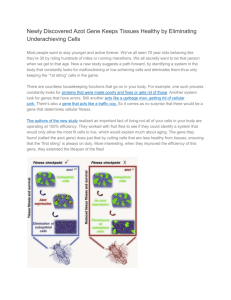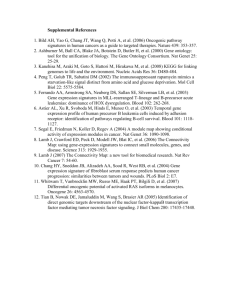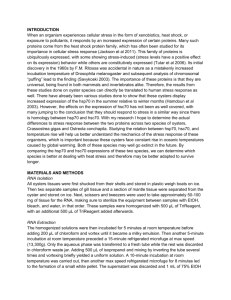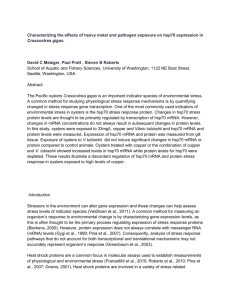JFB_3310_sm_as1
advertisement
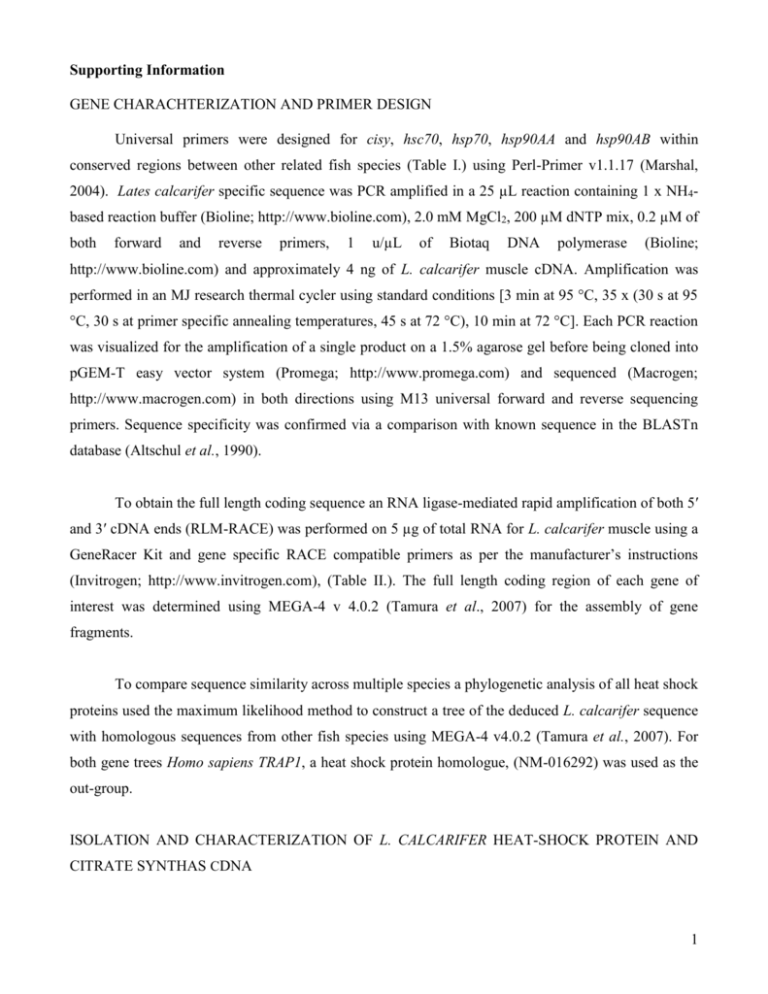
Supporting Information GENE CHARACHTERIZATION AND PRIMER DESIGN Universal primers were designed for cisy, hsc70, hsp70, hsp90AA and hsp90AB within conserved regions between other related fish species (Table I.) using Perl-Primer v1.1.17 (Marshal, 2004). Lates calcarifer specific sequence was PCR amplified in a 25 µL reaction containing 1 x NH4based reaction buffer (Bioline; http://www.bioline.com), 2.0 mM MgCl2, 200 µM dNTP mix, 0.2 µM of both forward and reverse primers, 1 u/µL of Biotaq DNA polymerase (Bioline; http://www.bioline.com) and approximately 4 ng of L. calcarifer muscle cDNA. Amplification was performed in an MJ research thermal cycler using standard conditions [3 min at 95 °C, 35 x (30 s at 95 °C, 30 s at primer specific annealing temperatures, 45 s at 72 °C), 10 min at 72 °C]. Each PCR reaction was visualized for the amplification of a single product on a 1.5% agarose gel before being cloned into pGEM-T easy vector system (Promega; http://www.promega.com) and sequenced (Macrogen; http://www.macrogen.com) in both directions using M13 universal forward and reverse sequencing primers. Sequence specificity was confirmed via a comparison with known sequence in the BLASTn database (Altschul et al., 1990). To obtain the full length coding sequence an RNA ligase-mediated rapid amplification of both 5′ and 3′ cDNA ends (RLM-RACE) was performed on 5 µg of total RNA for L. calcarifer muscle using a GeneRacer Kit and gene specific RACE compatible primers as per the manufacturer’s instructions (Invitrogen; http://www.invitrogen.com), (Table II.). The full length coding region of each gene of interest was determined using MEGA-4 v 4.0.2 (Tamura et al., 2007) for the assembly of gene fragments. To compare sequence similarity across multiple species a phylogenetic analysis of all heat shock proteins used the maximum likelihood method to construct a tree of the deduced L. calcarifer sequence with homologous sequences from other fish species using MEGA-4 v4.0.2 (Tamura et al., 2007). For both gene trees Homo sapiens TRAP1, a heat shock protein homologue, (NM-016292) was used as the out-group. ISOLATION AND CHARACTERIZATION OF L. CALCARIFER HEAT-SHOCK PROTEIN AND CITRATE SYNTHAS CDNA 1 PCR amplifications using degenerative primers yielded gene specific sequence for each previously uncharacterized L. calcarifer gene as confirmed by BLASTn analysis (Altschul et al., 1990). Two cDNAs were identified as members of the 90 kDa family of heat shock proteins. Their optical reading frames (ORF) and deduced amino acid sequences, as well as a phylogenetic analysis with homologues from other fish allowed them to be classified into the constitutive hsp90AB and the inducible hsp90AA forms of the gene (Fig. 1). Both peptides in L. calcarifer contain the three conserved regions (1, 2 & 3) and four variable regions (A, B, C & D) characteristic of members of this family as identified by Chen et al., (2006). Moreover both peptides contain the highly conserved MEEVD Cterminal region which designates them as active cytosolic members that mediate inter-domain communication and peptide-binding capacity (Gupta, 1995), as well as other important residues involved in ATP hydrolysis (E43), ATP binding (D89), geldanamycin binding (K108), geldanamycin and p23 binding (G91, G128, G131, G133 and G179), ATPase activity (R392 and Q396), interdomain interaction (F361) and casein kinase ІІ phosphorylation (S255) (Chen et al., 2006, Manchado et al., 2008). Two more cDNAs belonging to the 70 kDa family of heat shock proteins were also identified in the current study. A phylogenetic comparison of these two sequences with known members of the 70 kDa family from other fish species grouped each cDNA sequence separately and identified them as the constitutive hsc70 and inducible hsp70 forms of the gene (Fig. 2). Two highly conserved motifs were detected within both sequences with putative roles as an ATP-binding site and as a nuclear targeting signal respectively (Luft et al., 1996). Furthermore, despite a high sequence similarity at the peptide level, hsc70 and hsp70 could be differentiated at the C-terminal region. The constitutive hsc70 form of the gene is slightly longer than the inducible hsp70 and contains a repeated GG―P motif, as well as a signature SGPTIEEVD nonapeptide at the 3′ end of the sequence, whereas hsp70 contains only one GG―P motif (Deane & Woo, 2005) (Fig. 2). Phylogenetic analysis of the L. calcarifer hsp sequences by the maximum likelihood method clustered the hsp90AA and hsp90AB genes and hsp70 and hsc70 genes separately within distinct groups together with homologous genes from other fish species. In both cases bootstrapping results indicated strong support for the placement of genes into their respective clades (Fig. 3). A final cDNA identified as citrate synthase (cisy) was characterized in L. calcarifer and showed high sequence homology to citrate synthase in other fish species. Further confirmation of transcript identity was demonstrated by the presence of highly conserved α-helix zones (A-T) (Wiegand & 2 Stephen, 1986) as well as the presence of a hinge region involved in conformational change upon oxaloacetic acid (OAA) binding (G305 marked as # on Fig.4). Lates calcarifer citrate synthase was also revealed to contain other residues of importance such as multiple acetyl-CoA ligand binding sites (R76, K194, V344, V345, P346, G347, Y348, G349 and H350), oxaloacetate–citrate ligand binding sites (H268, H304, H350, R359, D408, R434, R451), catalytic residues (H304, H350 and D405) and other regions near binding sites or putatively involved in binding (H265, N272, D357, D405, D427) (Dalziel et al., 2005) (Fig. 4). The sequences encoding L. calcarifer hsp90AA, hsp90AB, cisy, hsc70 and hsp70 have been deposited on GenBank under the following Accession numbers; HQ646105, HQ646106, HQ646107, HQ646108 and HQ646109 respectively. 3 References Altschul, S. F., Gish, W., Miller, W., Myers, E. W. & Lipman, D. J. (1990) Basic local alignment search tool. Journal of Molecular Biology 215, 403-410. Chen, B., Zhong, D. & Monteiro, A. (2006). Comparative genomics and evolution of the HSP90 family of genes across all kingdoms of organisms. BMC Genomics 7, 156. Dalziel, A. C., Moore, S. E. & Moyes, C. D. (2005). Mitochondrial enzyme content in the muscles of high-performance fish: evolution and variation among fiber types. American Journal of Physiology, Regulatory, Integrative and Comparative Physiology 288, R163-172. Deane, E. E. & Woo, N. Y. S. (2005). Cloning and characterization of the hsp70 multigene family from silver sea bream: Modulated gene expression between warm and cold temperature acclimation. Biochemical and Biophysical Research Communications 330, 776-783. Gupta, R. S. (1995). Phylogenetic analysis of the 90 kD heat shock family of protein sequences and an examination of the relationship among animals, plants, and fungi species. Molecular Biology and Evolution 12, 1063-1073. Luft, J. C., Wilson, M. R., Bly, J. E., Miller, N. W. & Clem, L. W. (1996). Identification and characterization of a heat shock protein 70 family member in channel catfish (Ictalurus punctatus). Comparative Biochemistry and Physiology Part B 113, 169-174. Manchado, M., Salas-Leiton, E., Infante, C., Ponce, M., Asensio, E., Crespo, A., Zuasti, E. & Cañavate, J. P. (2008). Molecular characterization, gene expression and transcriptional regulation of cytosolic HSP90 genes in the flatfish Senegalese sole (Solea senegalensis Kaup). Gene 416. 77-84. Marshall, O. (2004). PerlPrimer: a cross-platform, graphical primer design for standard, bisulphate and real-time PCR. Bioinformatics 20, 2471-2472. Tamura, K., Dudley, J., Nei, M. & Kumar, S. (2007). MEGA4: Molecular Evolutionary Genetics Analysis (MEGA) software version 4.0. Molecular Biology and Evolution 24, 1596-1599. Wiegand, G. & Remington, S. J. (1986). Citrate Synthase: Structure, Control, and Mechanism. Annual Review of Biophysics and Biophysical Chemistry 15, 97-117. 4 5






